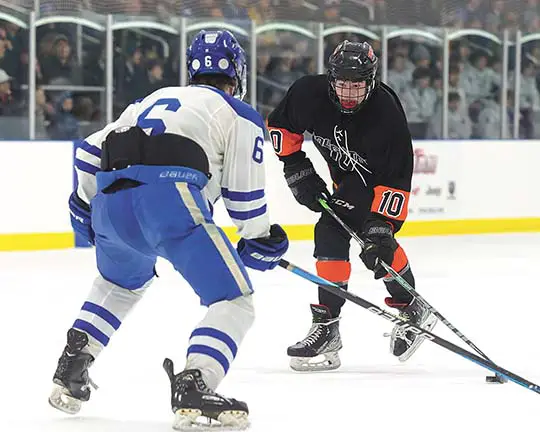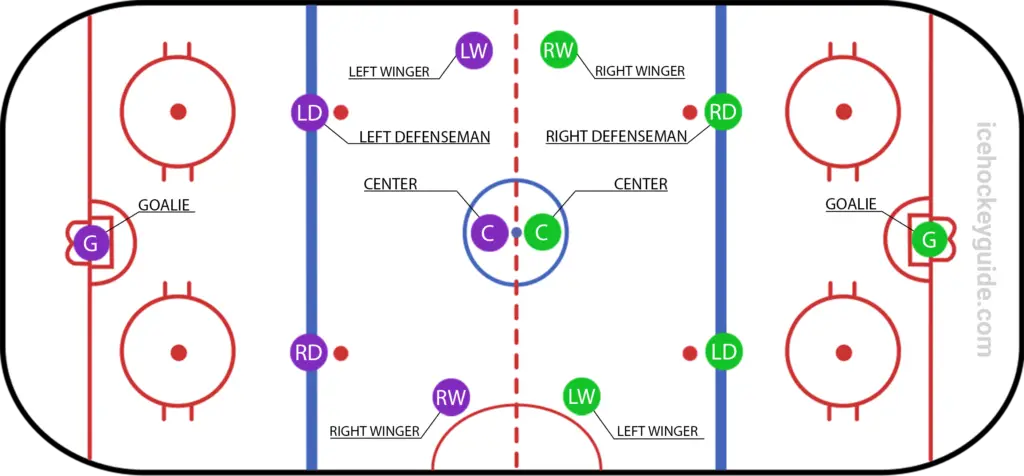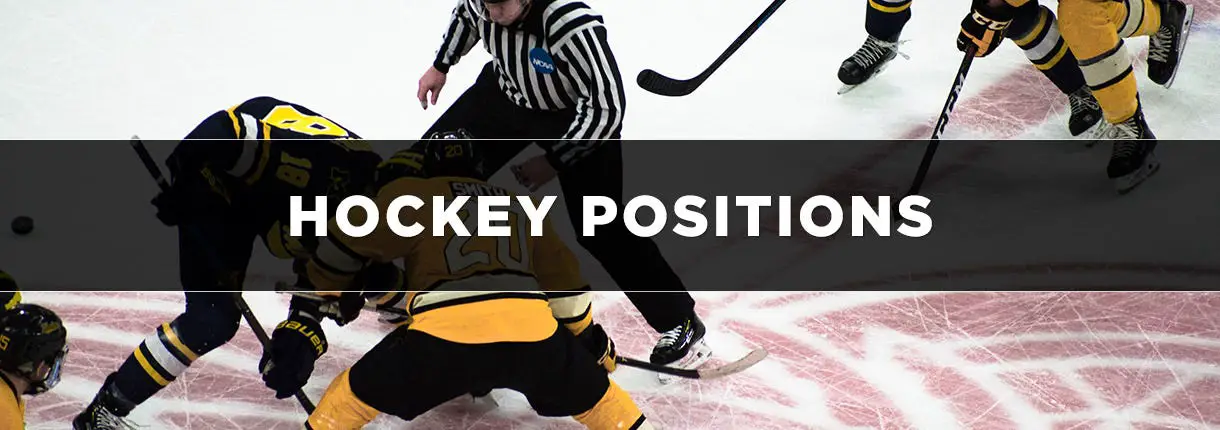In ice hockey, the forward position is responsible for scoring and assisting goals on the ice, typically staying in three different lanes from goal to goal. The forward position includes a center and two wingers, a left wing and a right wing.
Ice hockey forwards are crucial members of the team, contributing to the offensive plays by scoring goals and setting up scoring opportunities for their teammates. Their primary focus is to create offensive pressure on the opposing team by strategically positioning themselves to take shots on goal and disrupt the opponent’s defense.
Understanding the roles and responsibilities of hockey forwards is essential for both players and fans to comprehend the dynamics of the game. Whether it’s the speedy winger driving to the net or the playmaking center setting up plays, each forward role plays a significant part in the team’s overall success.

Credit: www.mininggazette.com
Table of Contents
The Roles Of A Hockey Forward
A crucial role on the ice, a hockey forward’s primary aim is to score and assist goals, positioned strategically in three lanes from goal to goal. With responsibilities as a sniper, playmaker, or grinder, forwards are key players in leveling up skills and maintaining their role through training.
Importance Of Forward Position
The forward position in ice hockey plays a vital role in the game. As the primary goal scorers and playmakers, forwards are responsible for creating scoring opportunities and driving the offense. They are the ones who strategize and execute plays, taking shots, passing the puck, and setting up teammates for goals. Without effective forwards, a team’s offense would be greatly compromised, and they would struggle to put points on the board.
Forwards are known for their speed, agility, and skill on the ice. They possess the ability to control the puck, outmaneuver opponents, and make split-second decisions to create scoring opportunities. Their contribution to the game is not only measured by goals and assists, but also by their ability to control the play, maintain possession, and create opportunities for their teammates.
Types Of Forward Players
There are various types of forward players in ice hockey, each with a unique set of skills and responsibilities. Understanding these different types can help coaches and players identify their strengths and contribute to the team’s success. Here are some common types of forwards:
| Type of Forward | Description |
|---|---|
| Sniper | A sniper is known for their exceptional goal-scoring ability. They have a precise shot and can find the back of the net from various positions on the ice. |
| Playmaker | A playmaker excels in passing and setting up their teammates for scoring chances. They have excellent vision and hockey IQ, often creating opportunities with their precise passes. |
| Power Forward | Power forwards are physically strong and skilled players who can dominate the game both with their scoring ability and physical presence. They can outmuscle opponents and create space for themselves and their teammates. |
| Two-way Forward | A two-way forward is known for their ability to excel in both offensive and defensive aspects of the game. They contribute not only in scoring goals but also in checking opponents and maintaining defensive responsibility. |
| Grinder | A grinder is a hard-working forward who excels in the gritty aspects of the game. They are known for their physicality, relentless forecheck, and ability to create turnovers. |
These are just a few examples of the different types of forwards in ice hockey. Each role has its own importance and contributes to the overall success of the team. A well-rounded forward unit consists of players with diverse skill sets who can complement each other and create a balanced and effective offensive attack.

Credit: icehockeyguide.com
Key Responsibilities
As a hockey forward, understanding your key responsibilities on the ice is crucial to the team’s success. Each forward position comes with its unique roles, from scoring goals to assisting and fulfilling defensive duties.
Scoring Goals
Scoring goals is one of the primary responsibilities of a hockey forward. It involves utilizing your shooting skills, speed, and agility to outplay the opposition’s defense and beat the goaltender. This requires strategic positioning and quick decision-making to capitalize on scoring opportunities.
Assisting Goals
Assisting goals is another key responsibility for a forward. Beyond personal goal-scoring, forwards must have the vision and passing ability to set up their teammates for scoring opportunities. This requires strong communication and awareness to create effective scoring chances for the team.
Defensive Duties
Defensive responsibilities are an essential part of a forward’s role. This includes backchecking to assist the defense, pressuring opponents to regain possession, and contributing to overall team defense. Forwards are often involved in defensive zone coverage to prevent the opposition from scoring.
The Booming Center
Role Of The Center
The center in hockey is a pivotal position responsible for setting up plays, winning faceoffs, and contributing to both offensive and defensive efforts.
- Facilitates teamwork with wingers and defensemen
- Controls the game’s tempo by directing play across all areas of the ice
- Key in executing both defensive and offensive strategies
Skills Required
To excel as a center, an individual must possess a diverse set of skills, combining agility, vision, and physicality:
Agility: A quick and agile skater with the ability to navigate in tight spaces.
Vision: Exceptional hockey IQ and awareness to anticipate plays and exploit openings.
Physicality: Strong on the puck, with the capability to withstand physical play and win crucial battles.
Wingers: Left And Right
The winger position in ice hockey is divided into left and right sides. Wingers are responsible for scoring and assisting goals, usually staying in three different lanes of the ice. They play a crucial role in the team’s offense and contribute to the overall strategy of the game.
Differences In Responsibilities
Wingers in ice hockey play a crucial role in the forward position, occupying the left and right sides of the ice. While their primary responsibility is to score and assist goals, each winger has unique responsibilities based on their position. Let’s take a closer look at the key differences in responsibilities between left and right wingers.Speed And Handling
When it comes to speed and handling, wingers need to excel in these areas to be effective on the ice. Both left and right wingers are expected to have quick acceleration and agile skating abilities. Since wingers often lead the attack and carry the puck into the offensive zone, their speed allows them to create scoring opportunities. Additionally, they must have excellent puck-handling skills to maintain control and make accurate passes under pressure. Now, let’s dive deeper into the responsibilities and characteristics of left and right wingers.Left Winger
The left winger’s primary responsibility is to support the center and contribute offensively. They typically stay on the left side of the ice and often shoot from their forehand, making it easier to score. Left wingers are known for their strong playmaking skills, setting up their teammates for scoring chances. Additionally, they play a crucial role in forechecking, pressuring the opposing team’s defense and disrupting their breakout plays.Right Winger
On the other hand, the right winger primarily supports the center and contributes offensively from the right side of the ice. Right wingers often shoot from their backhand, adding another dimension to their scoring potential. Similar to left wingers, they possess excellent playmaking skills and contribute to offensive zone pressure. Right wingers also play a critical role in defensive coverage, providing support to the defensemen and helping to protect the goalie. In conclusion, while left and right wingers share the responsibility of scoring and assisting goals, their positioning on the ice and shooting preferences differ. Left wingers showcase strong playmaking abilities and excel in forechecking, while right wingers bring additional scoring options with their backhand shots. Both wingers rely on speed, handling, and teamwork to contribute to their team’s success. By understanding the unique roles and responsibilities of left and right wingers, teams can optimize their offensive strategies and create a well-rounded line-up on the ice.Power Forward Position
A power forward in ice hockey is a player known for their combination of size, strength, and scoring ability. They are equally proficient at playing a physical game and putting points on the board. Let’s dive into the key characteristics and effectiveness of a power forward on the ice.
Characteristics Of A Power Forward
- Size and Strength: Power forwards are usually larger and stronger players on the ice, able to use their physicality to create space and win battles.
- Scoring Ability: Despite their physical presence, power forwards possess solid offensive skills, making them a dual threat in front of the net.
- Physical Play: Known for their gritty style, power forwards are not afraid to engage in board battles and provide a physical presence on the ice.
- Net-front Presence: They excel at screening the goalie, deflecting shots, and capitalizing on rebounds, often disrupting the opponent’s defensive strategy.
Effectiveness On Ice
- Creating Space: Power forwards use their size to open up lanes for teammates, allowing for better puck movement and scoring opportunities.
- Protecting the Puck: Their physicality helps them shield the puck from opponents, maintain possession, and make plays in the offensive zone.
- Forechecking: Power forwards lead the charge in forechecking, pressuring opposing defensemen, forcing turnovers, and creating scoring chances.
- Defensive Responsibility: While known for their offensive prowess, power forwards also contribute defensively by backchecking, blocking shots, and disrupting the opponent’s flow.

Credit: www.hockeymonkey.com
Frequently Asked Questions On Hockey Forward Position: Understanding The 11 Roles On The Ice
What Is The Forward Position In Ice Hockey?
In ice hockey, a forward position is responsible for scoring and assisting goals from three different ice lanes.
Where Do You Put Your Weakest Player In Hockey?
Place your weakest player on the left side as attackers often aim for the right side, making scoring easier. Stronger players set up plays on the right side, requiring more skills. Weaker players struggle with this.
How Many Forwards Are On The Ice In Hockey?
In ice hockey, there are typically three forwards on the ice for each team. These forwards consist of a center and two wingers, a left wing and a right wing. Their primary responsibility is to score and assist goals.
What Does A Power Forward Do In Hockey?
A power forward in hockey is a strong, physical player who excels in scoring goals while playing aggressively on the ice.
Conclusion
In ice hockey, the forward position is crucial in scoring and assisting goals. With three different lanes of the ice, forwards strategically navigate from goal to goal. A power forward is a strong player who excels in both physicality and goal-scoring.
Each team typically has three forwards: a center, left winger, and right winger. The main objective for forwards is to outsmart the opposing team’s goaltender and contribute to the overall success of the game. Understanding the various roles of forwards is essential for a well-rounded team.
